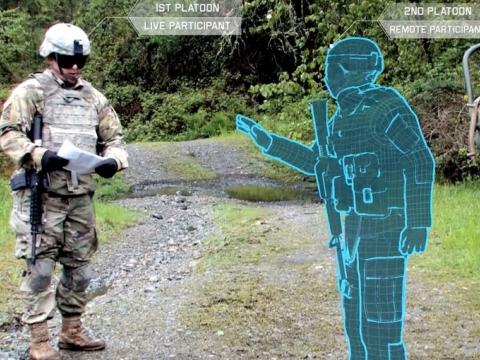Incoming: Extended Reality Offers the Military Boundless Opportunity, as Well as Risk
No longer an overhyped curio of the commercial gaming world, VR is advancing across the military community.
If you haven’t been paying attention, virtual reality (VR) is now real (pun intended). No longer an overhyped curio of the commercial gaming world, VR—along with augmented reality and other immersive technologies collectively known as extended reality (XR)—is advancing across the military community.
“This is cutting-edge technology,” Gen. James McConville, USA, now the U.S. Army’s chief of staff, told lawmakers in May. “It is going to transform the way we train soldiers and the way soldiers operate in combat. We’re excited about it.”
The Army and the Marine Corps are investing in a new battlefield head-up display, called the Integrated Visual Augmentation System (IVAS), that combines synthetic training environments with real-world data to boost the readiness and effectiveness of their infantry. The Navy and Air Force have been using similar XR technologies to train their fighter pilots.
Defense Department organizations already envision the boundless promise that XR advances holds for dramatically improved training, situational awareness, logistics support, combat readiness and even medical training and procedures.
The sheer breadth of increasingly common uses of XR are highlighted in a new report from my company, Accenture. It notes that industry spending on XR is set to overtake consumer demand during 2019 and will grow to triple the size of the consumer market by 2023. Remote brain surgery is just one seemingly futuristic application that is increasingly performed today. In March, Ling Zhipei performed China’s first remote, 5G-supported surgery on the human brain, and it was on a patient more than 1,800 miles from his location.
XR tools are also gaining ground in mental health therapy, including treatment of trauma, such as post-traumatic stress disorder, where virtual reality exposure therapy reportedly is reducing post-traumatic stress disorder symptoms in veterans and active-duty military personnel.
By superimposing virtual data over a view of the real world, military personnel can use XR technologies to navigate more easily across any terrain in the world; know the location of friendly troops or reported threats; train and rehearse for anticipated battle scenarios; and even overlay virtual enemies and obstacles as needed for better preparation. They can also train and practice for medical, maintenance or other specialized procedures.
The training applications of XR are particularly compelling because these technologies can help prepare military personnel for experiences that otherwise would be too expensive or logistically challenging.
For example, just this summer, the Defense Threat Reduction Agency solicited information on how XR can help troops better prepare for scenarios involving radiological threats.
Moreover, as 5G networks roll out, with their speed, capacity and data response coupled with the processing capacity of cloud technologies, XR is set to become extraordinarily accessible. Because people can train anywhere, anytime, they can refresh their training more frequently, if needed, so their learned skills stick with them for improved readiness.
Finally, XR can deliver training far faster and at less cost than traditional training in many cases. By employing virtual reality, artificial intelligence (AI) and biometric tracking, the Air Force has reduced pilot training from 12 months to four.
But while there are many opportunities for XR, there are also considerable risks and dangers. The data underlying XR is vulnerable to bias, misuse and cyber attacks. Both virtual and augmented reality can be manipulated for adverse purposes that could threaten our individual, mental and societal well-being.
Immersive technologies track some of our most intimate data: our feelings, judgments, reactions and broader sets of traits that make us who we are. Imagine what could happen when that information falls into the wrong hands.
Concern over fake news could turn to fake experiences. Consider a news source taking us to a controversial war zone through a virtual experience. How certain will we be that the experience has not been falsified or embellished to influence our opinion?
In applying today’s XR Technologies toward military use cases, Defense Department leaders will need to articulate clear rules and protocols for ensuring ethical, responsible behavior and uses, as they have already started to do with AI.
Also, defense organizations will need to extend risk assessments to look further into the future and to consider a broader range of direct and secondary impacts. Drawing on diverse experts, from neuroscientists to behavioral theorists, will help to create immersive systems and ways of operating that protect military personnel while mitigating technical risks.
With recent data-based innovations, we have had to scramble to get on top of the unintended consequences. If the Defense Department acts now, it has the time to seize the opportunities of XR and build in resilience that will be needed once XR becomes commonplace.
Lt. Gen. Susan Lawrence, USA (Ret.), is managing director for the Armed Forces Sector, Accenture Federal Services. She previously served as the CIO/G-6 for the U.S. Army as well as the commanding general for the Army’s Network Enterprise Technology Command (NETCOM).




Comments